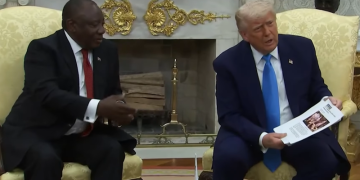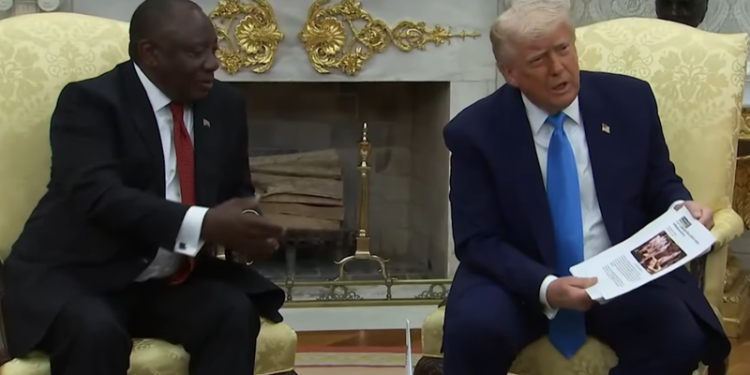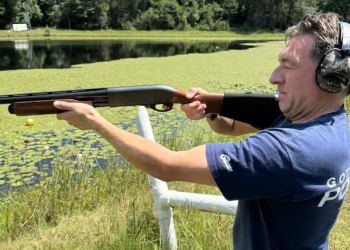A highly contentious meeting unfolded at the White House on Wednesday between U.S. President Donald Trump and South African President Cyril Ramaphosa, as Trump repeatedly advanced claims of widespread persecution against farmers in South Africa.
During the Oval Office meeting, President Trump asserted that white farmers in South Africa were facing systematic persecution, land confiscation without compensation, and being killed with impunity. To support his claims, he directed staff to dim the lights and played a video montage that included footage of South African opposition figure Julius Malema singing “Kill the Boer,” a controversial anti-apartheid song. Trump also presented what he described as articles and videos depicting “burial sites” of white farmers and widespread brutality, stating, “Death, death, horrible death.” Days prior to the meeting, the U.S. had granted asylum to nearly 60 Afrikaners, a move Trump stated was for those “fleeing South Africa for their own safety.”
President Ramaphosa, a veteran negotiator, sought to steer the conversation towards trade and bilateral relations. He brought a delegation that included prominent white South African golfers Ernie Els and Retief Goosen, along with the country’s richest man, Johann Rupert, in what was seen by some as an effort to defuse tension. Ramaphosa addressed the allegations raised by Trump, stating, “If there was Afrikaner farmer genocide, I can bet you, these three gentlemen would not be here.” He acknowledged that while criminality exists in South Africa, most victims of violence are black, and attacks are typically criminal. Post-meeting, Ramaphosa offered a positive assessment of the private discussions, noting productive trade talks and the possibility of Trump attending an upcoming G20 summit in South Africa.
In response to Trump’s assertions, political pundits and South African officials presented differing information. Reuters cited official South African police figures for 2024 indicating 26,232 murders nationwide, with 44 linked to farming communities, and eight of those victims being farmers; most murder victims in the country, according to reports, are black. South African courts have also issued rulings regarding claims of systematic persecution, stating they were “clearly imagined and not real” in certain cases. Regarding land reform, South African officials have stated that while the country’s new law allows for land expropriation without compensation in certain instances for public interest, no land has reportedly been forcibly taken under this act. They indicated that the government aims to redress historical inequalities from apartheid, where available data shows white South Africans, making up less than 8% of the population, still own over 70% of privately-owned farmland. Concerning the “Kill the Boer” song, three South African courts have ruled against designating it hate speech, citing its status as a historical liberation chant protected by freedom of speech, and South African officials have stated the song is not government policy. Additionally, reports indicated the video of crosses Trump displayed was from a 2020 protest and that the crosses did not mark actual graves. Similarly, an image he presented regarding “white farmers being burned” was reportedly identified as being from the Democratic Republic of Congo.
Reactions to the meeting were varied, reflecting differing perspectives on Trump’s approach and the underlying issues. Many South African media outlets and social media users praised President Ramaphosa for his calm and diplomatic handling of what they viewed as an “ambush” designed by some to humiliate him and South Africa. Patrick Gaspard, former U.S. ambassador to South Africa, described the meeting as “truly embarrassing,” asserting that “a trap was set for the South African president.” South African Ambassador Ebrahim Rasool had also been expelled in March after accusing Trump of “mobilising a supremacism.” These criticisms highlighted a perception of Trump’s treatment of a democratic leader, which some contrasted with his approach to authoritarian regimes.

Conversely, white South African right-wing groups and conservative commentators, including some MAGA supporters, applauded President Trump for amplifying their talking points on race relations in South Africa. Kallie Kriel, CEO of AfriForum, a South African NGO representing Afrikaners, acknowledged that his group had used some of the video footage Trump presented, believing the video was “very important to just get the shift to a situation that there can’t be denialism” regarding “real issues that need to be addressed.” Some within South Africa also expressed a desire for Ramaphosa to have “hit back harder” against Trump’s assertions. Julius Malema, the opposition leader whose song was featured in Trump’s video, mocked the meeting on social media, stating it was “a group of older men gathered in Washington to gossip about me.”
The meeting also touched on broader diplomatic tensions. The Trump administration had already frozen aid to South Africa and imposed tariffs, partly in response to South Africa’s land reform efforts and its decision to file a genocide case against Israel at the International Court of Justice (ICJ). Ramaphosa, keen to secure a trade deal, offered access to South Africa’s “critical minerals” to fuel U.S. industrial growth. Despite the public confrontation, Ramaphosa expressed optimism that private discussions might have been helpful, viewing the interaction as part of an ongoing process.




























